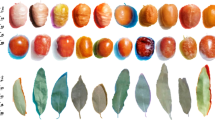Abstract
Local landraces of shallot from the Romagna region(Northern Italy) and North-western France, called ‘Scalogno di Romagna’ and ‘French grey’,respectively, have recently been evaluated for morphological,biochemical and molecular characters. These populations appeared very different from common shallots and onions, so were re-classified as Allium oschaninii O.Fedtsch., whereas almost no variability was observed within these types. Four ‘di Romagna’ and three French accessions were grown in Italy, and further evaluated for quality characters such asbulb colour and volatile oil content and composition. Colour was measured by means of a tristimulus colorimeter. Volatile oil was extracted by hydrodistillation and its components separated and identified by GC/MS. Colour parameters differentiated the‘di Romagna’ from the ‘French grey’accessions. Essential oil composition differed from what has been reported for most other Alliums, by a lower amount of1-propenyl- substituents. No individual oil component allowed a good differentiation of the two geographic origins.However, the French and ‘di Romagna’ accessions were perfectly separated by the discriminant analysis of oil composition.Minor 1-propenyl- components seemed more critical for discrimination. The shallot types examined seemed biochemically differentiatedfrom Allium cepa. Variation in the examined quality characters was detected both between the two provenances and among the accessions of common geographic origin.
Similar content being viewed by others
References
Block E. 1992. The organosulphur chemistry of the genus Allium. Implications for the organic chemistry of sulphur. Angewandte Chemie. International edition English 31: 1135–1178.
Boscher J., Auger J., Mandon N. and Ferary S. 1995. Qualitative and quantitative comparison of volatile sulphides and flavour precursors in different organs of some wild and cultivated garlics. Biochemical Systematics and Ecology 23: 787–791.
D'Antuono L.F., Lovato A.F.S. and Dellacecca V. 1995. Lo Scalogno di Romagna. Osservazioni su caratteri morfologici e Produttivi. In: Corbetta F., Pacioni G., Tammaro F. and Marra L. (eds), Funghi, tartufi ed erbe mangerecce. Proceedings Interna-tional Congress Accademia Italiana di cucina, L'Aquila September 28–October 1., pp. 87–98.
D'Antuono L.F. 1998. A new taxon among vegetable crops?. Allium Improvement Newsletter 8: 1–3.
D'Antuono L.F., Dellacecca V. and Lovato A.F.S. 1998. Storia, utilizzazioni e sistematica dello scalogno di Romagna. In: Agab-bio M. (ed.), Atti 4° Convegno nazionale: biodiversità: germop-lasma locale e sua valorizzazione. Alghero 8–11 Settembre, Carlo Delfino, Sassari., pp. 837–840.
Fenwick G.R. and Hanley A.B. 1985. The genus Allium. Part 2. CRC Critical reviews in food science and nutrition 22: 273–377.
Freeman G.G. and Whenham R.J. 1975. A survey of volatile components of some Allium species in terms of S-alk(en)yl-L-cysteine sulphoxides present as flavour precursors. Journal of the Science of Food and Agriculture 26: 1869–1886.
Friesen N. and Klaas M. 1998. Origin of some minor vegetatively propagated Allium crops studied with RAPD and GISH. Gen. Res. Crop. Evol. 45: 511–523.
Linne von Berg G., Samoylov A., Klaas M. and Hanelt P. 1996. Chloroplast DNA restriction analysis and the infrageneric group-ing of Allium (Alliaceae). Plant systematics and evolution 200: 253–261.
Maaß H.I. 1996. About the origin of the French grey shallot. Gen. Res. Evol. 43: 291–292.
Maaß H.I. 1997. Studies on triploid viviparous onions and their origin. Genetic resources and crop evolution 44: 95–99.
Mc Guire R. 1992. Reporting of objective colour measurements. Hortscience 27: 1254–1255.
Randle W.M. 1997. Onion flavor chemistry and factors influencing flavor intensity. In: Risch F. and Ho C.T. (eds), Spices: Flavour chemistry and antioxidant properties. American Chemical Socie-ty, Washington, pp. 41–52.
1993. Disciplinare di produzione integrata Scalogno di Romagna. In: Mirandola G. (ed.), Scalogno di Romagna. Cinque anni. Regione Emilia-Romagna. Comune di Riolo Terme, Associazione turistica Pro-loco., pp. 51–58.
Schulz H., Kruger H., Liebemann J. and Peterka H. 1998. Distribution of volatile sulphur compounds in a interspecific hybrid between onion (Allium cepa L.) and leek (Allium porrum L.). Journal of Agriculture and Food Chemistry 46: 5220–5224.
Steel R.G.D. and Torrie J.H. 1980. Principles and Procedures of Statistics. A Biometrical Approach. McGraw—Hill Kogakusha Ltd, Tokyo, 633 pp.
Wu J.L., Chou C.C., Chen M.H. and Wu C.M. 1982. Volatile flavour compounds from shallots. Journal of Food Science 47: 606–608.
Yu T.H., Wu C.M., Rosen R.T., Hartman T.G. and Ho T. 1994. Volatile compounds generated from thermal degradation of alliin and desoxialliin in an aqueous solution. Journal of Agriculture and Food Chemistry 42: 146–153.
Author information
Authors and Affiliations
Corresponding author
Rights and permissions
About this article
Cite this article
Filippo D'Antuono, L., Moretti, A. & Neri, R. Evaluation of ‘di Romagna’ and ‘Frenchgrey’ shallots for quality characters connected to bulb colourand volatile oil content and composition. Genetic Resources and Crop Evolution 49, 175–182 (2002). https://doi.org/10.1023/A:1014786625804
Issue Date:
DOI: https://doi.org/10.1023/A:1014786625804




